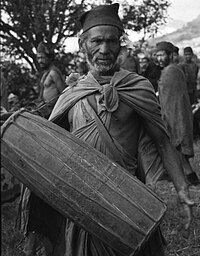This article includes a list of general references, but it lacks sufficient corresponding inline citations. (May 2016) |

Raute are a nomadic traveling ethnic group officially recognized by the Government of Nepal. They are known for subsistence hunting of langur and macaque monkeys. They gather wild forest tubers, fruits, and greens on a regular basis. To obtain grain (rice), iron, cloth, and jewelry, they carve wooden bowls and boxes to trade for goods from local farmers (Shahu, 2019). They do not sell other forest products, bushmeat, or forest medicinal plants. Raute do not share their language, hunting strategies and worship practices to the villagers to maintain their cultural purity. These days, they are accepting gifts and allowances from the government and non-government organizations in regular basis.
Their population is estimated at 650, with 618 in Nepal's 2011 census,[1] people living in small settlements in the regions of western Nepal. Most have been forcibly settled by the government of Nepal but there are about 150 nomadic Raute, who, as late as 2016, still chose to live a nomadic life. The government of Nepal has permitted them to cut down small trees in state - run forests needed for poles in erecting their tents, which often puts them in friction with the local population.[2] The Raute move from place to place, spending no more than 4 to 5 months at one place at a time, and often no more than a few days, in search of better water sources, or of villages where they can sell their wood products for food staples.
The Raute language is called "Raute" in most studies and sometimes "Khamci," meaning "our talk" in a few other studies. It is closely related to the language spoken by two related ethnic groups, the Ban Raji ("Little Rulers of the Forest") and Raji ("Little Rulers") of the same region (Fortier and Rastogi 2004).
Rautes emphasize that they wish to remain full-time foragers and not assimilate into the surrounding farming population.
- ^ Central Bureau of Statistics of Nepal. (2011). National Population and Housing Census 2011 (Vol. 1). United Nations Statistics Division. Retrieved from https://unstats.un.org/unsD/demographic/sources/census/wphc/Nepal/Nepal-Census-2011-Vol1.pdf
- ^ BBC Documentary on Nomadic Life|Kate Humble, Kate Humble: "Living with Nomads 1/3 Nepal" on YouTube, BBC Documentary / Nov 2016, minutes 14:02–17:13.
© MMXXIII Rich X Search. We shall prevail. All rights reserved. Rich X Search
